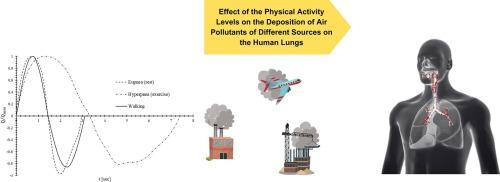体育活动水平对不同来源的空气污染物在人体肺部沉积和运输的影响
IF 4.6
2区 工程技术
Q2 ENGINEERING, CHEMICAL
引用次数: 0
摘要
空气污染物对人体肺部健康的影响是巨大的,在大城市中越来越令人担忧。最常见的污染物是灰尘、交通废气和烟雾。本文用数值方法研究了不同运动水平下这些2 ~ 10 μm大小的污染物在真实人体肺模型中的沉积和迁移。研究了代表三种身体活动水平的三种真实的呼吸特征,即呼吸暂停(休息)、行走和呼吸急促(运动)。研究发现,除了污染物的大小和类型外,身体活动水平对污染物在上呼吸道(URT)的沉积速率和位置至关重要。例如,在Hyperpnea条件下,7 μm粉尘的沉积率为70%;然而,在Eupnea条件下,该值为23%。这项研究提供了一幅清晰的画面,说明身体活动水平如何以及在多大程度上影响不同大小和类型的污染物对人体肺部的损害。本研究结果有助于采取预防措施,减少对个体肺部的损害,改善哮喘和慢性阻塞性肺疾病(COPD)等呼吸系统疾病的预后。本文章由计算机程序翻译,如有差异,请以英文原文为准。

The impacts of physical activity levels on the deposition and transportation of air pollutants of different sources in the human lungs
The effects of air pollutants on the human lungs' health are significant and are becoming increasingly alarming in megacities. The most common pollutants are dust, traffic emissions, and smoke. In this paper, the deposition and transportation of these pollutants of sizes ranging from 2 μm to 10 μm under various physical activity levels in a realistic human lung model are investigated numerically. Three realistic breathing profiles representing three physical activity levels, Eupnea (rest), Walking, and Hyperpnea (exercise), are investigated. It is revealed that, in addition to the pollutant size and type, the physical activity level is vital in determining the deposition rate and location of the pollutants in the upper respiratory tract (URT). For instance, the deposition rate of 7 μm dust is 70 % under the Hyperpnea condition; however, this value is 23 % under the Eupnea condition. This study presents a clear picture of how and to what extent the physical activity levels can affect the damage from the pollutants of different sizes and types to the human lungs. The outcomes of the presented research can benefit the preventive actions in reducing the damage to individuals' lungs and the prognosis of respiratory diseases such as asthma and chronic obstructive pulmonary disease (COPD).
求助全文
通过发布文献求助,成功后即可免费获取论文全文。
去求助
来源期刊

Powder Technology
工程技术-工程:化工
CiteScore
9.90
自引率
15.40%
发文量
1047
审稿时长
46 days
期刊介绍:
Powder Technology is an International Journal on the Science and Technology of Wet and Dry Particulate Systems. Powder Technology publishes papers on all aspects of the formation of particles and their characterisation and on the study of systems containing particulate solids. No limitation is imposed on the size of the particles, which may range from nanometre scale, as in pigments or aerosols, to that of mined or quarried materials. The following list of topics is not intended to be comprehensive, but rather to indicate typical subjects which fall within the scope of the journal's interests:
Formation and synthesis of particles by precipitation and other methods.
Modification of particles by agglomeration, coating, comminution and attrition.
Characterisation of the size, shape, surface area, pore structure and strength of particles and agglomerates (including the origins and effects of inter particle forces).
Packing, failure, flow and permeability of assemblies of particles.
Particle-particle interactions and suspension rheology.
Handling and processing operations such as slurry flow, fluidization, pneumatic conveying.
Interactions between particles and their environment, including delivery of particulate products to the body.
Applications of particle technology in production of pharmaceuticals, chemicals, foods, pigments, structural, and functional materials and in environmental and energy related matters.
For materials-oriented contributions we are looking for articles revealing the effect of particle/powder characteristics (size, morphology and composition, in that order) on material performance or functionality and, ideally, comparison to any industrial standard.
 求助内容:
求助内容: 应助结果提醒方式:
应助结果提醒方式:


